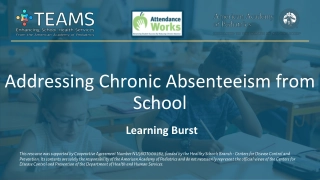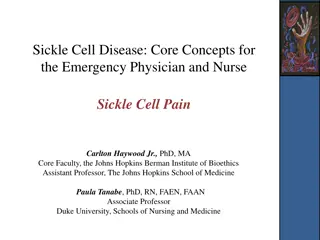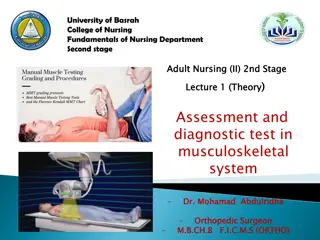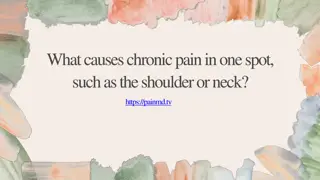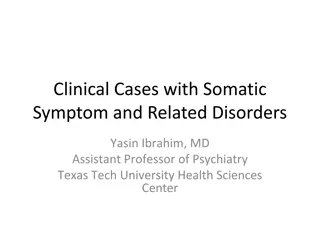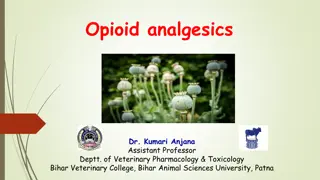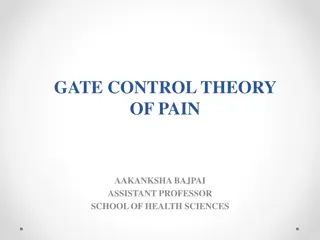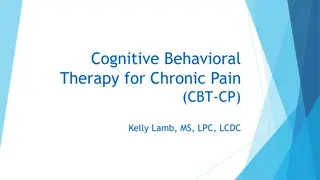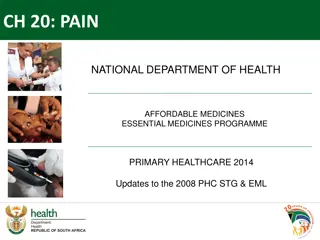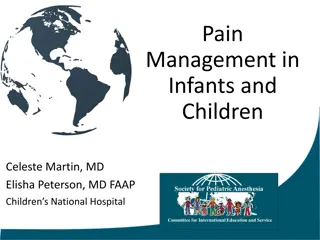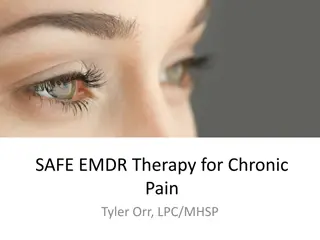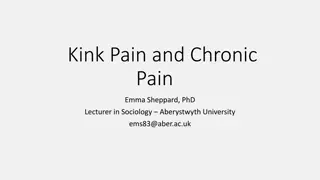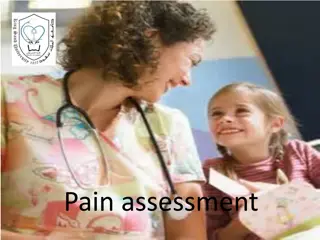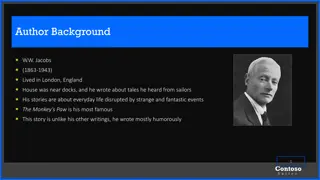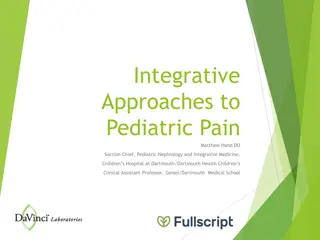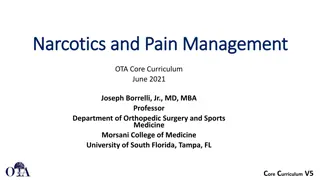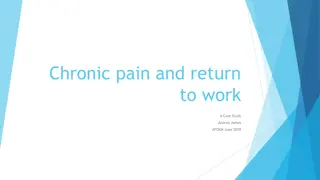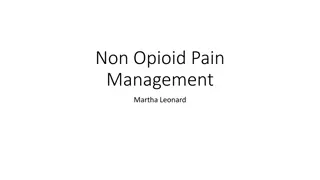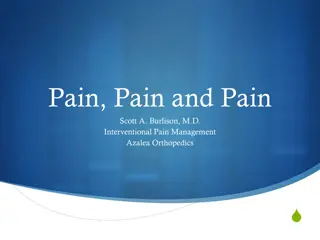Managing Chronic Pain in Schools and Colleges: Insights from Dr. Konrad Jacobs
Explore the challenges of managing pain, fatigue, and physical symptoms without clear pathology in educational settings. Learn about acute versus chronic pain, the purpose of pain, effects of the sympathetic nervous system, and the role of expectations in pain experiences.
Download Presentation

Please find below an Image/Link to download the presentation.
The content on the website is provided AS IS for your information and personal use only. It may not be sold, licensed, or shared on other websites without obtaining consent from the author. Download presentation by click this link. If you encounter any issues during the download, it is possible that the publisher has removed the file from their server.
E N D
Presentation Transcript
Managing Chronic Pain In Schools and Colleges Dr Konrad Jacobs Consultant Clinical Psychologist Oxford Centre For Children and Young People in Pain @oxfordpain @konradjacobs
What are the biggest issues you face at school in relation to pain / fatigue / physical symptoms without a clear pathology? Please write these in the chat
Aims What is Acute Pain? What is Chronic or Persistent Pain? Managing chronic pain in school and colleges
What is Acute Pain? Usually comes on suddenly and is caused by something specific. It is sharp in quality. Usually does not last long It goes away when there is no longer an underlying cause for the pain
Pain is our body s protection system
Why do we need to feel pain? Alert To warn us something bad has happened Warning Something bad might happen Healing To stop us doing more damage Learning To remind us not to do it again
Effects of Sympathetic Nervous System (SNS). This is your FIGHT or FLIGHT or FREEZE response to a situation Senses more Alert Eyes, Skin Increased tension in Muscles Increased rate of breathing Feeling of Nausea Increased Heart Rate Increased production of Adrenaline and Cortisol All this can lead to an increase feeling of Agitation
Anticipation of Pain. Your brain starts to think about what might go wrong even before it has happened! Pain Memories . Our CNS will remember an event that caused pain so we do not do it again
Summary - Acute Pain Has a Trigger Stops once your injury/illness has healed Medication works Draws your attention It s Warning you to protect It s the body s way of saying it feels threatened It s Useful
Biomechanical Pain Muscle weakness / tightness / overexertion Often the result of lack of activity or changes in posture
Chronic Pain Complex Regional Pain Syndrome CRPS Juvenile Fibromyalgia Syndrome FMS (LIPS; DIPS) Headache Back pain Recurrent Abdominal Pain - RAP Hypermobility syndrome Ehlers Danlos Syndrome Biomechanical Other
What do we know about chronic pain??
CHRONIC PAIN IS COMMON!! Perquin et al. 18 16 14 12 10 Boys Girls 8 % 6 4 2 0 0 - 3 4 - 7 8 - 11 12 - 15 16 - 18 Age in Years
Chronic Pain can Occur in ANY Part of the Body
Chronic Pain 1. Injury Healed or spontaneous pain 2. Healing has finished . 3. Warning Far too soon 4. Learning .... the wrong message!
Perception Sometimes the Brain can interpret information in a way which it thinks is helpful, but this is not always the case. For Example, these optical illusions .
Can you see the triangles? Are they really there?? Sometimes our brain tries to help us by creating a perception of something it thinks should or could be there, but it misinterprets
1. Pain is complex! 2. Sensory input goes into the brain ..and becomes a pain experience 3. because the brain interprets there is a threat to the system 4. Both peripheral sensors as well as the brain become more sensitive to normal information ( sensitisation )
Chronic Pain Metaphors In the case of chronic pain, the Pain system has become Like a Fire alarm that is too sensitive
Chronic Pain Metaphors How is it possible I am in so much pain when they did not find anything on scans / blood tests (or found things but it does not explain the extent of my pain)?? In the case of chronic pain, there is nothing (or not much) wrong with the hardware (the body), but rather, the software (pain processing) is faulty These are some really nice metaphors of what is happening in chronic pain. You can use these to explain chronic pain to others.
Fight / Flight / Freeze response to chronic pain Fight: You feel overwhelmed and get angry. E.g. you lash out at family, get angry with yourself or your pain Flight: You feel overwhelmed and want to leave the situation you are in, e.g. leaving school, an outing with friends, Freeze: You feel overwhelmed and do not want to leave the situation you are in, e.g. you want to stay at home and not go to school, out with friends, etcetera
Treatment Medical Treatments Often fail Rehabilitation Gradual return to normal activities, including school Address biomechanical issues Return to normal family life Address psychological functioning Address systemic issues Address other issues: sensory problems, ASD, bullying, etcetera
Chronic Pain Management Need to move from thinking about a cure for pain To thinking about managing the pain To try to be as active as possible despite pain To accept pain as a given at this stage of life To reduce negative thinking / emotions To normalise family life
The spiral can go down, and the spiral can go up! Pain Sleep Doing things Mood / stress
Summary: Chronic Pain Long Term: > 3 months Often not understood by others Not Visible Does not respond well to medications It s not warning you of a current injury/illness but your brain thinks it s under threat Not Useful It is real
Psychological or Physical Symptoms are not only psychological or physical Pain leads to negative feelings Negative feelings can lead to more pain and disability (via fight-flight-freeze response and threat perception) but pain usually does not go away completely when negative feelings do
Fluctuations in performance Fluctuations are NORMAL And are NOT signs of malingering But instead are related to fluctuations in THREAT perception
Parents The LARGE MAJORITY of parents do their best in difficult circumstances Factitious or induced illness by proxy? When to involve safeguarding / MASH?
Negative things Children & parents say about school They don t believe I am in pain / tired / have physical symptoms They don t understand that some days I can do more than other days They are not being helpful / accommodating Not all the teachers know about my pain Other children make comments They treat me as if I am doing this to my child
Engagement Being empathetic and explicit in conveying belief in the reality of the experience of physical symptoms Shift focus from cause to symptom management Avoid physical versus psychological discussions Use physical illness analogies to illustrate approach ( what we do with children with other health conditions is . ) Challenge therapeutic nihilism/room for optimism
Management - 1 ENGAGEMENT! Take seriously even in cases of clear manipulation Reduction in anxiety levels Normalising symptoms ( We have lots of other children with pain in the school ) Close contact with teams / school / GP to avoid splitting in cases when child / parent is highly distressed; don t be afraid to contact clinicians and ask questions (with permission of the family)
Management - 2 Phased return to school same number of hours each day Who does the child / parent get on with in the school? It does not always have to be the HOY, it is about engagement with the family Clear, timely communication these parents are often very worried Weekly one-to-one check-in with favourite teacher to discuss the week and any difficulties that have arisen
Management - 3 Pain-flare planning: what does the young person do / where does s/he go in case of pain flares at school? Address practical issues: moving around the school, going to the toilet, carrying a heavy bag with books Share the Pain and school website (see resources ) Try to avoid confrontations Put it all together in a mutually agreed written plan which is reviewed regularly
Useful Resources Website Recommendations: Pain bytes : http://www.aci.health.nsw.gov.au/chronic-pain/painbytes/ Pain and School: https://www.aci.health.nsw.gov.au/chronic-pain/painbytes/pain-and- school Retrain pain: http://www.retrainpain.org/ Understanding Pain in 5 minutes: https://www.youtube.com/watch?v=C_3phB93rvI Book Recommendations: Tonya Palermo - Managing your Child s Chronic Pain Frances Cole - Overcoming Chronic Pain (for older adolescents / adults) Moseley & Butler The Explain Pain Handbook Protectometer Jennifer Shannon The Anxiety Survival Guide for Teens Cathy Creswell & Lucy Willetts Over Coming your Child s Fears & Worries
Konrad.jacobs@ouh.nhs.uk Joint conference MNIS and OXCYPP 26.02.2021 02.02.2021 09.02.2021 All your EHCP questions will be answered



